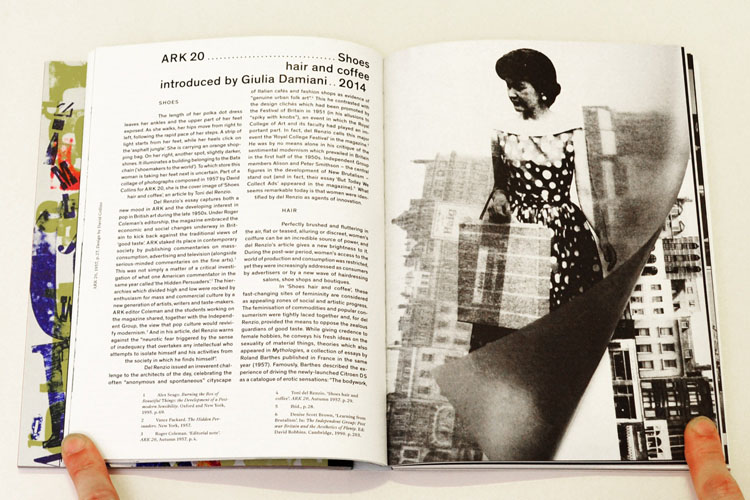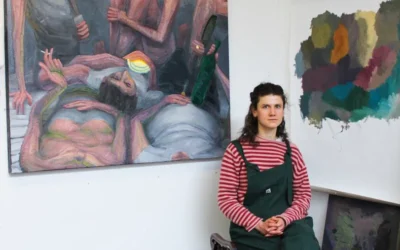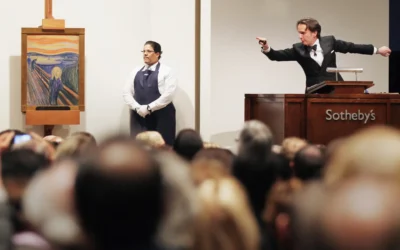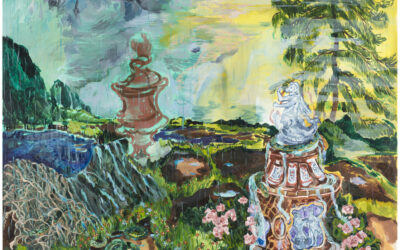By Giulia Damiani.
Shoes.
The length of her polka dot dress leaves her ankles and the upper part of her feet exposed. As she walks, her hips move from right to left, following the rapid pace of her steps. A strip of light starts from her feet, while her heels click on the ‘asphalt jungle’. She is carrying an orange shopping bag. On her right, another spot, slightly darker, shines. It illuminates a building belonging to the Bata chain (‘shoemakers to the world’). To which store this woman is taking her feet next is uncertain. Part of a collage of photographs composed in 1957 by David Collins for ARK 20, she is the cover image of ‘Shoes hair and coffee’, an article by Toni del Renzio.
Del Renzio’s essay captures both a new mood in ARK and the developing interest in pop in British art during the late 1950s. Under Roger Coleman’s editorship, the magazine embraced the economic and social changes underway in Britain to kick back against the traditional views of ‘good taste’. ARK staked its place in contemporary society by publishing commentaries on mass-consumption, advertising and television (alongside serious-minded commentaries on the fine arts).[1] This was not simply a matter of a critical investigation of what one American commentator in the same year called ‘the Hidden Persuaders’.[2] The hierarchies which divided high and low were rocked by enthusiasm for mass and commercial culture by a new generation of artists, writers and taste-makers. ARK editor Coleman and the students working on the magazine shared, together with the Independent Group, the view that pop culture would revivify modernism.[3] And in his article, del Renzio warns against the “neurotic fear triggered by the sense of inadequacy that overtakes any intellectual who attempts to isolate himself and his activities from the society in which he finds himself”.
Del Renzio issued an irreverent challenge to the architects of the day, celebrating the often “anonymous and spontaneous” cityscape of Italian cafés and fashion shops as evidence of “genuine urban folk art”.[4] This he contrasted with the design clichés which had been promoted by the Festival of Britain in 1951 (in his allusions to “spiky with knobs”), an event in which the Royal College of Art and its faculty had played an important part. In fact, del Renziocalls this major event the ‘Royal College Festival’ in the magazine.[5] He was by no means alone in his critique of the sentimental modernism which prevailed in Britain in the first half of the 1950s. Independent Group members Alison and Peter Smithson – the central figures in the development of New Brutalism – stand out (and in fact, their essay ‘But Today We Collect Ads’ appeared in the magazine).[6] What seems remarkable today is that women were identified by del Renzio as agents of innovation.
Hair.
Perfectly brushed and fluttering in the air, flat or teased, alluring or discreet, women’s coiffure can be an incredible source of power, and del Renzio’s article gives a new brightness to it. During the post-war period, women’s access to the world of production and consumption was restricted, yet they were increasingly addressed as consumers by advertisers or by a new wave of hairdressing salons, shoe shops and boutiques.
In ‘Shoes hair and coffee’, these fast-changing sites of femininity are considered as appealing zones of social and artistic progress. The feminisation of commodities and popular consumerism were tightly laced together and, for del Renzio, provided the means to oppose the zealous guardians of good taste. While giving credence to female hobbies, he conveys his fresh ideas on the sexuality of material things, theories which also appeared in Mythologies, a collection of essays by Roland Barthes published in France in the same year (1957). Famously, Barthes described the experience of driving the newly-launched Citroen DS as a catalogue of erotic sensations: “The bodywork, the lines of union are touched, the upholstery palpated, the seats tried, the doors caressed, the cushions fondled; before the wheel, one pretends to drive with one’s whole body.”[7]
Ironic and playful, del Renzio’s essay contains some provocative ideas. He accuses men – the patriarchy shaping architecture in Britain – of “being fearful and traditionalist”. Women, by contrast, are open “to avant-garde ideas and new concepts, as well cultural, economic and social changes”.[8]Barthes’ celebration of the bodywork of the car can be compared to the alluring undertones that del Renzio finds in the General Motors Technical Centre in Michigan, a landmark of modern architecture designed by Eero Saarinen and inaugurated in 1956. By quoting its symbolic ‘sex appeal’, del Renziohints at the sexual and psychological effects of design – something that would be discussed 40 years later by figures like Beatriz Colomina.[9]
And coffee.
“Linked to this appeal to women is the Italian influence over the products offered in these places” wrote del Renzio.[10] After salons and stores, he gives his readers a taste of the dark beans, the varied beverages, and the wallpapers of the Italian cafés in the UK which were, of course, frequented by female consumers. At the same time, Italian scooters were being advertised as products for the emancipated woman, a fact which perhaps accounts for their nickname, the ‘hairdresser’.[11] These new mechanical objects echoed a fascination for Italy that was directly imported from America.
Together with the feminine appropriation of the market, at first the iconic US pop culture was deeply contrasted.[12] Yet the initial stiffness dissolved quickly into the British art scene; del Renzio lists names of popular Italian shops and venues which, with their ‘macaronic’ style, provided the means to reinvigorate British design. The Italianate trend was given permission to conquer ARK, the RCA and its students and, in fact, London itself (legally or otherwise).
By Toni del Renzio.
A supporter of ‘vernacular taste’, Antonino Romanov del Renzio Rossi di Castellone e Venosa (Toni del Renzio) was born in Russia in 1915 and died in the UK in 2007 at the age of 92. Descended from the Russian Tsars, he fought in Mussolini’s army in Abyssinia in 1935, before deserting, disguised as a Bedouin. After having studied mathematics and philosophy in Italy and the USA, he reached Paris in 1937 where he worked as a theatre designer and painter, close to avant-garde art circles. To escape Hitler’s march on France, del Renzio crossed the English Channel to London, determined to revitalise the surrealist movement in England. Following his attempt to rouse a new enthusiasm for surrealist activity by publishing the magazine Arson: An ardent review. Part One of a Surrealist Manifestation (only one issue appeared in 1942), del Renzio fell into conflict with the British Surrealist Group’s leading figure, E. L. T. Mesens, and left it in 1951. He emerged as one of the leading voices of the Independent Group, contributing to the celebrated This Is Tomorrow exhibition at the Whitechapel Gallery in London in 1956. From the late 1950s onward, he worked as an art director and writer for several fashion and art magazines, including Flair, Harper’s Bazaar and Vogue, among others. By 1965 he was involved in film and television production, writing scripts and even acting; his appearance in The Good, the Bad and the Ugly deserves a mention. In his later years, del Renzio taught in two British art schools, Canterbury and Corsham. At the age of 70, he achieved another kind of notoriety, making national headlines with the birth of his quadruplets. Throughout his life, del Renzio’s ideas and writing style were unpredictable and often incendiary. His voice and views were permanently in flux; to him, only a few words were constantly true: “art could never be pure”.[13]
*This text appears in ARK: Words and Images from the Royal College of Art Magazine
1950-1978, published by Critical Writing in Art & Design at the Royal College of Art.
[1] Alex Seago. Burning the Box of Beautiful Things: the Development of a Postmodern Sensibility. Oxford and New York,1995. p.69.
[2] Vance Packard. The Hidden Persuaders. New York, 1957.
[3] Roger Coleman. ‘Editorial note’. ARK 20, Autumn 1957. p.4.
[4] Toni del Renzio. ‘Shoes hair and coffee’. ARK 20, Autumn 1957. p.29.
[5] Ibid., p.28.
[6] Denise Scott Brown, ‘Learning from Brutalism’. In: The Independent Group: Post war Britain and the Aesthetics of Plenty. Ed: David Robbins.Cambridge, 1990. p.203.
[7] Roland Barthes. Mythologies. Paris, 1957. p.90.
[8] Del Renzio. ‘Shoes hair and coffee’. ARK 20, Autumn 1957. p.28.
[9] See Beatriz Colomina, Sexuality and Space. New York, 1992.
[10] Del Renzio. ‘Shoes hair and coffee’. ARK 20, Autumn 1957. p.28.
[11] Dick Hebdige, Hiding in the Light: On Images and Things. New York, 1998. p.46.
[12] Ibid., p.70.
[13] Toni del Renzio. ‘Pioneers & Trendies’. In: The Independent Group: Postwar Britain and the Aesthetics of Plenty. Ed: David Robbins. Cambridge, 1990. p.179.



